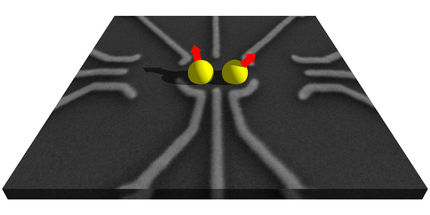A step toward optical transistors?
McGill researchers demonstrate new way to control light in semiconductor nanocrystals
As demand for computing and communication capacity surges, the global communication infrastructure struggles to keep pace, since the light signals transmitted through fiber-optic lines must still be processed electronically, creating a bottleneck in telecommunications networks.
While the idea of developing an optical transistor to get around this problem is alluring to scientists and engineers, it has also remained an elusive vision, despite years of experiments with various approaches. Now, McGill University researchers have taken a significant, early step toward this goal by showing a new way to control light in the semiconductor nanocrystals known as "quantum dots."
In results published online in the journal Nano Letters, PhD candidate Jonathan Saari, Prof. Patanjali (Pat) Kambhampati and colleagues in McGill's Department of Chemistry show that all-optical modulation and basic Boolean logic functionality – key steps in the processing and generation of signals – can be achieved by using laser-pulse inputs to manipulate the quantum mechanical state of a semiconductor nanocrystal.
"Our findings show that these nanocrystals can form a completely new platform for optical logic," says Saari. "We're still at the nascent stages, but this could mark a significant step toward optical transistors."
Quantum dots already are used in applications ranging from photovoltaics, to light-emitting diodes and lasers, to biological imaging. The Kambhampati group's latest findings point toward an important new area of potential impact, based on the ability of these nanocrystals to modulate light in an optical gating scheme.
"These results demonstrate the proof of the concept," Kambhampati says. "Now we are working to extend these results to integrated devices, and to generate more complex gates in hopes of making a true optical transistor."
The findings build on a 2009 paper by Kambhampati's research group in Physical Review Letters. That work revealed previously unobserved light-amplification properties unique to quantum dots, which are nanometer-sized spheroids with size-dependent optical properties, such as absorption and photoluminescence.
Most read news
Other news from the department science

Get the chemical industry in your inbox
By submitting this form you agree that LUMITOS AG will send you the newsletter(s) selected above by email. Your data will not be passed on to third parties. Your data will be stored and processed in accordance with our data protection regulations. LUMITOS may contact you by email for the purpose of advertising or market and opinion surveys. You can revoke your consent at any time without giving reasons to LUMITOS AG, Ernst-Augustin-Str. 2, 12489 Berlin, Germany or by e-mail at revoke@lumitos.com with effect for the future. In addition, each email contains a link to unsubscribe from the corresponding newsletter.



























































